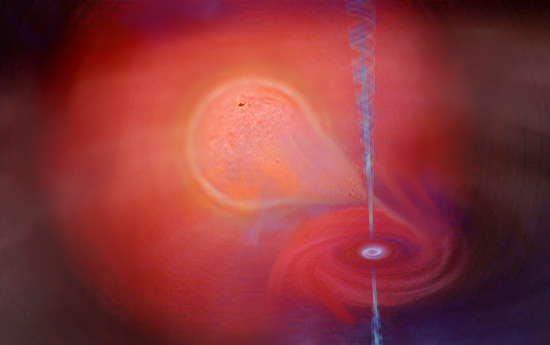BY LETTER
Multiple Systems
 Image from Steve Bowers | |
| Castor, a multiple system (image shows this system before stelllar engineering took place) | |
About 85% of all stars are in double or multiple systems. Some of the types are:
- Cataclysmic Variables - Comprising white dwarf primaries with M-type companions in semi-detached systems. Characterised by short periods. Accretion is often onto the white dwarf component.
- Algols - Algol systems comprise two 'normal' main sequence or subgiant stars in a semi-detached system.
- W Serpens Stars - These are active Algol systems. (see Algol)
- RS Canum Venaticorum Stars - Chromospherically active binaries of F and later spectral type components.
- BY Draconis Stars - Similar to RS Canum Venaticorum systems.
- W Ursae Majoris Contact Systems - Short period (0.2 to 0.8 day) contact binaries exhibiting very high levels of magnetic activity.
- X-Ray Binaries - Binaries with a neutron star or, more rarely, a black hole primary. Accretion onto the primary produces strong x-ray emissions.
- Zeta Aurigae Systems - Long period binaries comprising interacting type G or K supergiant and hot (type B) companion. Although not originally interacting systems, they become so when the more massive star evolves to become a supergiant.
- VV Cephei Systems - Similar to Zeta Aurigae binaries except a type M supergiant replaces the G or K type.
- Symbiotic Binaries - Long period (
- Barium and S-Star Binaries - Long period binaries in which the originally more massive component evolved into a white dwarf, transferring some of its nuclear-processed gas to a giant type K or M companion.
- Post-Common Envelope Binaries - Usually comprising a hot white dwarf or subdwarf, and a cooler secondary, which have passed through the common envelope phase. The binary nuclei of planetary nebulae are examples.
 Image from Steve Bowers | |
| An X-Ray binary system consisting of a red giant and a black hole | |
Celestia information | |
| To download Castor | The Castor system is available for download for the Celestia Space simulation program. The new model can be downloaded from this link: models and data copyright Phil Batchelor. |
|---|---|
| Please note | If you have the OA Universe add-on installed you will need to remove the file 'castor.ssc' from that add-on, as this new add-on supercedes it |
Related Articles
Appears in Topics
Development Notes
Text by Chris Clowes
Initially published on 08 December 2001.
Initially published on 08 December 2001.






